 Abstract Reasoning Practice
Abstract Reasoning Practice
- Practise real abstract psychometric test questions like the ones used by employers
- Review your mistakes with full answers and explanations
- Get comprehensive insider tips to hone your skills to the fullest
This page contains general information about abstract reasoning tests, along with 4 sample questions.
For a full-length test, check out our full free abstract reasoning test simulation.
Employers across various industries now use AI pre-recorded interviews as an essential screening stage. Ensure you're fully prepared with JobTestPrep's AI Interview Preparation.
Ace Your Job Search with a Custom Prep Kit
Job hunting doesn't have to be stressful.
Prepare smarter and ace your interviews faster with our Premium Membership:
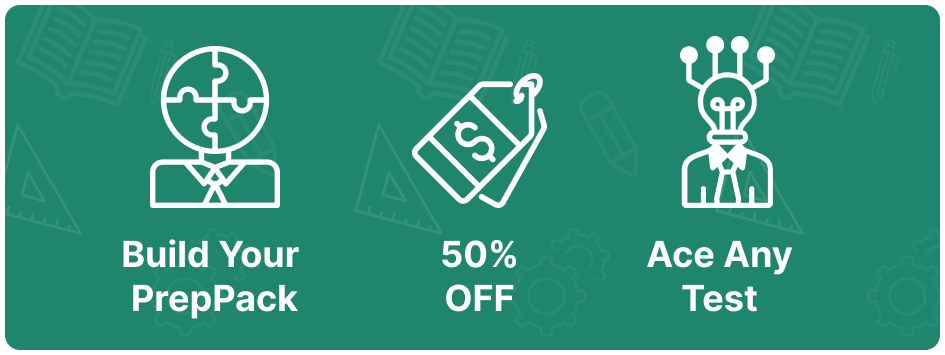
See What People Think About Our Membership
What Is an Abstract Reasoning Test?
Abstract reasoning tests, also known as conceptual reasoning assessments, are non-verbal in nature and consist of questions that include shapes and images. They are widely used as part of pre-employment aptitude or psychometric assessments.
The exam measures your lateral thinking and fluid intelligence with the sole purpose of determining how quickly you can identify patterns, logical rules, and data trends.
The test is meant to inform your future employer how capable you are at learning new skills, thinking strategically about problems, and analysing new information.
For this challenging assessment, your current skills may not be enough.
💡 Learn more about other common aptitude tests.
▼ Skip to the sample questions
Abstract reasoning tests are designed to take you to the edge of your cognitive ability.
They are, more often than not, timed. They use non-verbal prompts, irregular shapes, and complex patterns that don't look like anything we deal with in our daily lives. More than any other tool, employers use abstract reasoning assessments to separate the weak candidates from the strong ones.
It's no surprise, then, that many find them stressful.
Practice helps. Our one-size-fits-all Abstract Reasoning PrepPack™ features all types of questions and covers all the skills and competencies covered by real abstract tests: spatial reasoning, pattern recognition, deduction, induction, etc.
With full-length mock tests, odd-one-out, analogies, next-in-series, matrices, and more. Full solutions, explanations, and study guides. Get yours now!
How to Improve Your Abstract Reasoning Results
Improving your abstract reasoning results can prove difficult if you do not know where to begin. Thus, when given a new question, remember that the first step is identifying the question type.
To do this, you must pay close attention to the patterns and colours contained within the image. For example, what are the differences or similarities?
Once you feel confident in knowing the question types, your mental ability to break down each puzzle will greatly improve, allowing you to score higher on your test.
Look at the solving method breakdown in the images below to further help you formulate your answer.
What to Focus On?
The first thing to understand is that not all abstract tests are equal in regard to difficulty levels. However, while different style tests will vary in difficulty, test questions within the same test will be comparable in difficulty.
There are three primary ways in which a test can differ. Some tests demand the use of a greater number of logical rules in order to successfully define shapes. Other tests use fewer, more complex rules. Lastly, tests can give you more time or less time to answer each question. Generally, tests that employ more than three rules give test takers under 30 seconds, while tests with under three rules usually give up to 45 seconds per question.
Abstract Example Questions
There are many different types of abstract questions, however, most are similar and share a common core.
Below we have grouped together the 4 most frequently used question types to help you distinguish between and answer them quickly.
Below is one example question in each category. You can take our full abstract reasoning free test.
Or, you can
Matrices Sample Question
1) Matrices: Matrices are a group of separate images that follow a particular pattern. Your task is to understand the pattern and cipher which image should appear next. Matrices are one of the most common abstract reasoning drills and are used in tests such as the Alva Labs Test, Matrigma Test, and Raven's Progressive Matrices (RPM).
Below is an example:

The correct answer is

In each row two shapes are united to create the third with the exception of the outline of the outermost shape which remains constant (the square in the first row, circle in the second row and diamond in the third row). In the first row, the united figure is on the left; in the second figure it is on the right and in the bottom row it should be in the centre. Therefore, the missing figure should have a diamond outline and have only a black dot in the centre so when combined with the figure on the left will create the figure in the centre.
Next In Series Sample Question
2) Next In Series: Here you are presented with several images in a row. It is your job to comprehend the pattern and find the missing image.
Note: The missing image will not necessarily be at the end of the row. Frequently it can be found in the middle of the line.
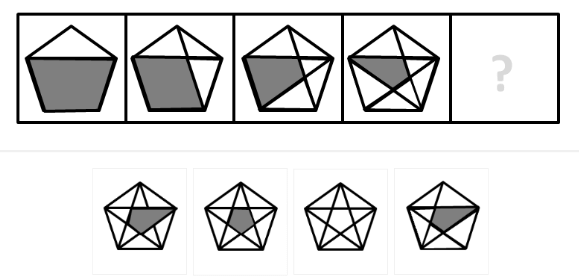
The correct answer is
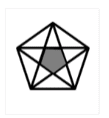
There are two characteristics in this question: the number of chords (lines) drawn, and shading. First, look at the chords. In each frame, an additional chord is drawn from one corner (vertex) of the pentagon to another corner directly across from it. If you label each corner of the pentagon with a number, it is easier to see.
The first chord is drawn from vertex one (to vertex three).
The next chord is drawn from vertex two (to vertex four).
The next from vertex three (to vertex five).
The final one is drawn from vertex four (to vertex one).
Therefore, the missing shape is the one with the chord drawn from vertex five, creating the star shape inside the pentagon.
This eliminates answer choices one and four as they do not contain the star shape. Next, look at the shading in the shape. Each time a new chord is drawn, it reduces the amount of grey shading. The shading always lies on the inside of the chord boundaries. When drawing the final chord from vertex five, the remaining space inside that chord is just in the centre of the star. Therefore, it can only be answer choice two.
Odd One Out Sample Question
3) Odd One Out: Unlike matrices and next in the series, odd one out questions do not follow a particular pattern. Rather you must determine which shape is different from the rest in the series. Below is an example:
Choose the figure that does not share a common pattern with the other four:

The correct answer is
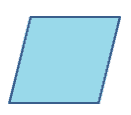
Every shape in the sequence, aside from this one, is symmetrical on a vertical axis, while the parallelogram is symmetrical on a diagonal axis.
Analogies Sample Question
4) Analogies: In this series of questions, you are presented with two pairs of images. One pair will be complete, the second incomplete. While the two pairs are similar in pattern, there will be differences.
So, you will have to identify what is similar in the first set and organically implement it to second set of shapes.
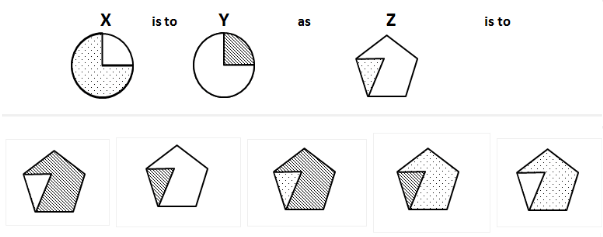
The correct answer is

The relationship between figure X and figure Y is as follows:
Figure Y represents figure X with:
1) The dotted section becoming white, and
2) The white section becoming shaded
The correct answer must have the same relationship with figure Z.
Answer 2 can be eliminated as the blank section remains blank, and the dotted section becomes shaded instead of becoming blank.
Answer 3 can be eliminated as the dotted section remains dotted.
Answer 4 can be eliminated as the blank section becomes dotted instead of becoming shaded, and the dotted section becomes shaded instead of becoming blank.
Answer 5 can be eliminated as the blank section becomes dotted instead of shaded.
We are left with answer 1, which is the correct answer, as it portrays figure Z while the blank section becomes shaded and the dotted section becomes blank.
Abstract Reasoning Test Tips
Oftentimes when given a new abstract question, candidates become overwhelmed with the sequence of pictures. With the right information, however, you can build your confidence and answer correctly.
The first step is to take into account the shapes, colour, location, direction, rotation, movement, and order of each image.
If you are having difficulty solving the question, try beginning at the end of the sequence. Next, use the information you have learned from the sample questions.
Remember:
- Matrices include a group of figures in a single panel. Each panel follows a certain rule or pattern. You will determine what this pattern is and choose the answer that fits best.
- Next in the Series are questions that have a row of images that follow a pattern. Identify the pattern to determine the next in the sequence.
- Odd One Out present you with several images in an order that follows a particular pattern. Find the images that do not fit the pattern.
- Analogies begin with two pairs of shapes that share a relationship. Your task is to locate the relationship and implement it into one of the given answers.
Hopefully, now, you will feel more familiar with the common question types. If you still are having trouble visualising the questions, reread the sample questions shown above.
Get Ready to Ace Any Test Throughout Your Job Search
One membership, three PrepPacks, 50% off. The smartest way to stay prepared throughout your job search.
Get started today!

Prepare for a Specific Test Provider
Optimise Your Efforts with our Specialised PrepPacks™ - We Help Over 40,000 Job-Seekers Each Year Get A better Score
All major test provers have at least one abstract reasoning test, including UCAT, Aon cut-e, SHL, and Talent-Q (Korn Ferry). This is why practising any generic version of abstract practice is crucial during your preparation.
However, it is best to find out which test provider whose test you will take. Each assessment provider differs from the rest.
For example, while the general information will remain the same, you will find the format, style, and questions represented differently. So, to give yourself the best chance of passing try to find out which test provider the employer uses.
Our exclusive PrepPacks™ have been created by experts in the field. Furthermore, We collect feedback from our customers to gain insight into the efficacy of our practice material and to ensure they are up to date.
More Free Practice
We at JobTestPrep find the assessment tests world highly diverse and fascinating. If you are looking to deepen your knowledge in the aptitude tests world, or you want some extra practice before your test, we've got you covered!
Check out these fantastic free practice tests (all are completely free):
Free Aptitude Test | Free Psychometric Test | Free Numerical Reasoning Test | Free Verbal Reasoning Test | Free Cognitive Test | Free Critical Thinking Test | Free Abstract Reasoning Test | Free Spatial Reasoning Test | Free Personality Test | Free Inductive Test | Free Mechanical Reasoning Test
Other related tests: Hudson A-RAT 3R Test Prep


